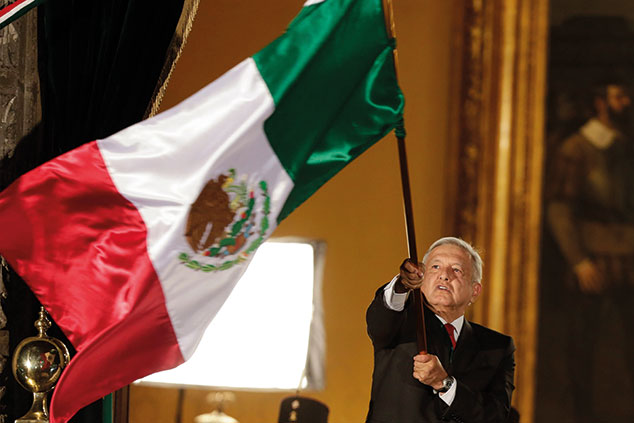
Who is AMLO?
He’s Andrés Manuel López Obrador, 66, the left-wing, anti-corruption president universally known to Mexicans by his initials. He has just marked his first year as Mexico’s highly popular president.
To understand AMLO’s appeal, outsiders need first to understand the extent to which Mexico’s politics has been wholly dominated for the past century by the Institutional Revolutionary Party (PRI), founded by leaders of the Mexican Revolution.
Though it began as a leftist party, the PRI morphed over the decades into a politically fluid national party that allowed the country’s elites to thrash things out among themselves before deigning to bother the people at election time. It was also brutally authoritarian when its interests were threatened.
For most of its recent history, Mexico was in effect a one-party PRI state – and a textbook study in cronyism and corruption.
Then what happened?
In the 1980s, the ruling PRI embraced privatisations and free-market capitalism, leading to a split. Like everyone else in Mexican politics, AMLO began his career as a member of the PRI. But in the 1980s he joined the left-wing party that split off from it.
AMLO later led that party, the PRD, and served as mayor of Mexico City, before becoming disillusioned with the continuing corruption of Mexican politics after narrowly losing the 2012 presidential election to the PRI candidate.
AMLO’s solution was to start his own Morena party (the “Movement for National Regeneration”) that would end 36 years of “neo-liberal” economic governance and defeat the corrupt “power mafias” once and for all.
So AMLO is a populist?
He’s certainly popular, with approval ratings above 60% a year on from coming to power (having beaten the PRI candidate in the 2018 election). Yet AMLO is not quite an aggressive “populist” in the sense of a Perón, or a Chávez, or even a Trump. Supporters say AMLO is more an old-fashioned leftist – overhauling the budget to introduce a raft of programmes to help small farmers, the elderly and students – but with a good streak of pragmatism, a surprising level of fiscal conservatism and a resolute focus on anti-corruption.
What do sceptics say?
He’s a populist with the potential to wreck Mexico’s economy – the second biggest in Latin America – and steer the country towards authoritarianism.
As president, with a strong grip on the legislature and beholden to no party chieftains, AMLO wields considerable power and critics worry he is “threatening some of Mexico’s hard-won democratic gains”, reckons Mary Beth Sheridan in The Washington Post. Critics say he is “weakening federal and civil institutions that safeguard human rights and clean elections”.
He is also steering cash grants to the poor and vulnerable, and circumventing the normal bureaucratic channels in the interests of limiting corruption. In short, say detractors, AMLO is using public money to build up a massive base of client-loyalists, like many Latin American leftwing populists before him.
How’s his presidency going?
Not great. AMLO campaigned on a promise to achieve 4% average growth over his six-year term – outstripping the average of 2% a year during the period since 1983. Even three months ago, the president was promising that despite evidence of a fast-slowing economy, Mexico would grow by that modest 2% this year.
Instead, the economy has fallen into recession, with negative growth in the first two quarters and the likelihood of zero growth in 2019 overall. Meanwhile, Mexico’s well-documented problems with violence from drug cartels have not abated.
What’s going wrong?
AMLO’s view that Mexico has experienced disappointingly low growth for decades – at 2.5% over the past 25 years it’s around half the emerging market average – is widely shared. “But his solution is more controversial,” says the Financial Times.
In a nutshell, AMLO is making a huge bet on additional government investment into the state oil company, Pemex – plus infrastructure projects targeted on the poorer states – to boost the Mexican economy rather than fostering the private sector.
Supporters would argue that he has already doubled old-age pensions, boosted the minimum wage, provided direct cash transfers to students and apprentices and implemented programmes to revive the rural economy in depressed southern states – all the while keeping the currency reasonably stable and not putting up taxes.
Sceptics say that even cunningly targeted largesse is obviously not sustainable in an economy with such entrenched problems.
What are they?
Mexico’s economy tops a list of 36 OECD nations for hours worked, but it’s the least productive and the oversupply of cheap labour is a brake on innovation.
What’s more, the informal sector is vast, notes Eric Martin in Bloomberg Businessweek. Workers on the taco carts or shoe-shine stands that proliferate in any main boulevard in Mexico City “don’t pay taxes, foregoing the benefits of a social safety net”. Mexico collects only 16% of GDP in taxes, skewed towards corporate taxes.
But AMLO has ruled out a major tax overhaul aimed at widening the tax base. Meanwhile, corruption remains endemic. “Mexico is basically a dual economy,” says Alberto Ramos, chief Latin America economist at Goldman Sachs. “Some enclaves are globally integrated.
And then there’s the countryside, with [poor]education… where productivity growth has been zero for 50 years.” It remains to be seen whether AMLO has the ability to ameliorate all this, or whether Mexico is edging towards even greater economic and social turmoil.